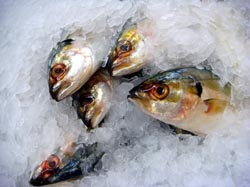High-pressure processing for food safety
Currently established methods for processing and producing food primarily concentrate on combining different processes to achieve desired qualities and shelf-life. With the exception of fermentation and the addition of preservatives, these processes primarily have a purely physical effect on the food matrix. With the recent application of high hydrostatic pressure a new opportunity arose to efficiently control phase changes during the treatment of foods at low temperatures. The SAFE ICE project, supported by the Fifth Framework Programme, sought to estimate the impact of new high-pressure low-temperature (HPLT) processes on quality attributes of frozen foods. Research work carried out at the Berlin University of Technology focused on processing effects on cellular material, which included plant tissue (potato tubers), fish tissue and micro-organisms (Listeria innocua). Samples were cooled under pressure below 0 grades Celcius, but kept in the liquid state according to the corresponding phase diagram. Once the desired temperature was reached, pressure was released inducing quasi-instantaneous nucleation of ice crystals throughout the sample. The uniform nucleation in the sample combined with reduced phase transition times usually result in a better-preserved microstructure of the processed food and importantly, less drip losses. But although the use of high pressure is not an impediment, long processing times are still required. Therefore, before introducing HPLT processes in the food industry, these times must first be optimised. For this purpose, an empirical model was adapted to accurately describe the melting curves of different ice polymorphs for pressure levels up to 400MPa. Moreover, pressure-supported freezing was investigated to develop a model enabling the calculation of temperature profiles and the pressure-dependent freezing points. Different metastable states of water (liquid and solid) were experimentally observed and defined according to their process-dependent stability. Furthermore, the impact on cellular material was investigated by texture and impedance analysis to evaluate the state of the cellular membranes in the sample after treatment. On the basis of the accumulated results and with respect to essential processing criteria, different food processing strategies were proposed to effectively use the potential of high-pressure application.



